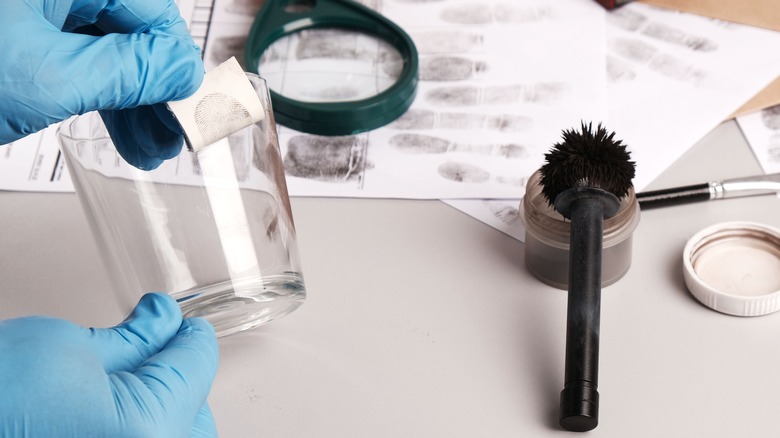The Disturbing Crime Scene Of Stacey Stanton's Murder
The following article includes some graphic details of the murder of Stacey Stanton.
When the local newspaper first reported the death of Manteo, North Carolina resident Stacey Stanton in early February 1990, the outlet spared readers the gruesome details of the 28-year-old woman's brutal murder. Stanton, a transplant to Manteo, located in the Outer Banks, from New Jersey, was a much-loved waitress at a local restaurant called The Duchess of Dare (per All That's Interesting). When Stanton missed her shift on February 3, it alarmed her co-workers.
The Coastland Times reports that after she missed part of her shift, one of her co-workers, Tina, dropped by Stanton's apartment to check in on her. Stanton's residence on Ananias Dare Street was mere blocks from the restaurant, which Tina was able to walk to in just a few moments (via Wickedness). When Tina let herself into Stanton's apartment, she found a horrific crime scene; the aftermath of a savage attack and murder. After arriving on the scene, investigators pieced together what they thought happened since the last time anyone saw Stanton alive.
Stanton had suffered multiple stab wounds during the attack
Stanton was found dead on the living room floor of her apartment. She was laid out on a mattress, half-naked atop a pool of blood (via FindLaw). Though it was apparent to investigators that Stanton was stabbed to death, the extent of her injuries could not be determined until an autopsy was conducted.
From what was initially gleaned from the crime scene was that Stanton fought with her attacker. The Virginian-Pilot reports that in her hands, she still clutched clumps of hair that she ripped from the person who murdered her. These hairs were also found scattered across her chest. Her chest was covered in wounds in which the investigators determined to have been caused by a knife. Investigators were able to identify at least 14 separate stab wounds on Stanton's body and that most of these wounds were on the victim's neck, stomach, and chest. A bloody washcloth was found nearby with police reporting that they believed it was used by the killer to clean themselves after the attack (via All That's Interesting).
Stanton was most likely mutilated post-mortem
After an autopsy, it was revealed that Stanton most likely died due to the deep wounds she suffered in her neck. Two slashes of her attacker's knife were enough to penetrate the soft tissue of her throat, causing her to bleed to death (via All That's Interesting). Upon further examination, it was noted that Stanton also suffered knife wounds on more sensitive regions of her body. Clad in only sweatpants, investigators initially surmised that Stanton was sexually assaulted. An examination later revealed that there was no evidence of this crime.
Disturbing details were revealed during Stanton's autopsy. Conducted by Greenville Medical Examiner Dr. L.S. Harris on Feb. 4, 1990, he determined that much of what Stanton endured at the hands of her murderer was post-mortem, or while she was close to death. In the official autopsy report, Harris wrote that wounds to sensitive regions were characteristic of "a fetishistic activity on the part of the assailant" (per The Virginian-Pilot).
But who was her killer? There were several sets of fingerprints found in Stanton's apartment, the hair that she presumably pulled from her killer's head, and a morning newspaper that was delivered outside her door but was found inside her residence. The evidence should have been enough to get the right person arrested and behind bars. But as it turns out, that's not how this case was fated to unfold.
If you or anyone you know has been a victim of sexual assault, help is available. Visit the Rape, Abuse & Incest National Network website or contact RAINN's National Helpline at 1-800-656-HOPE (4673).
A friend of Stanton's was the prime suspect
Clifton Eugene Spencer was a close friend of Stanton. The pair were often seen together, usually at one of the local bars. On February 2, 1990, Spencer was playing pool with Stanton's ex-boyfriend Mike Brandon along with a few other people. Spencer recalls that he was being given a hard time by some of the other bar patrons because as he was the only Black person there that night. When he decided to leave the bar, he saw Stanton in the parking lot of her apartment talking to a man that Spencer didn't know. She called out to him, asking Spencer to have Brandon come out and talk to her. Spencer went back into the pub and relayed the message, but Brandon declined to leave (The Virginian-Pilot).
Later, Spencer went to Stanton's apartment. She was alone and he found her drinking vodka. She sent him out to acquire crack cocaine, but when he returned to her apartment approximately 30 minutes later, he relayed that he was unable to find any. But the two stayed up for a while, continuing to drink. Spencer says that he passed out at Stanton's apartment, awaking during the early morning hours and leaving. He then went to a friend's home and slept there. His friend later said that Spencer arrived at 4:30 a.m. (per The Coastland Times).
After Stanton's body was found, investigators quickly determined that the last person who admitted seeing her alive was Spencer. All suspicion fell on him as a case was built for his arrest.
Spencer plead no-contest in court to his friend's brutal murder
Investigators found multiple sets of fingerprints in Stanton's apartment. Among them were ones that belonged to Spencer. He admitted to the police that he was in the apartment but denied killing her. Police state that Spencer failed a polygraph test and it was at that time that the department decided to charge him with first-degree murder. Ultimately, Spencer pleaded no contest in court (per All That's Interesting). Under the direction of his attorney, this would enable him to avoid the death penalty the state was seeking (per The Virginian-Pilot). He was sentenced to life in prison.
The case against Spencer was flimsy, however. It was be revealed that the hair Stanton clutched in her hands was from a Caucasian male. Spencer had no blood on his clothing when he arrived at his friend's house later that morning (per The Virginian-Pilot). He also had no motive. And the polygraph test that police stated that he failed? There was never a record of the exam ever even being administered, let alone his failure of the alleged test.
Though Spencer appealed his conviction, it was denied when a judge ruled in 1993 that the plea was voluntary and he was ordered to serve the remainder of his sentence. In 1995, a private investigator administered two polygraph tests to Spencer; both of which passed (per All That's Interesting). But changes to the law that occurred in 2001 gave Spencer a glimmer of hope in a pathway to exoneration and freedom, which included the bloody washcloth left behind at the crime scene.
Spencer is a free man today
In 2001, a law was passed that allowed convicted felons to have DNA tests performed on evidence if none was done so prior to their trial. As no DNA tests were administered on the bloody washcloth, Spencer was granted his request to have his DNA sample taken and compared to the DNA left behind on the evidence (via The Coastland Times).
After the tests were performed in 2005, it was determined that Spencer's DNA was not present on the washcloth. In 2007, a new team of attorneys was provided to Spencer by The Innocence Project and were able to secure his release from prison (per All That's Interesting). Since his release, Spencer currently works as an over-the-road truck driver. His story recently gained attention recently, as it was highlighted on the podcast "Counterclock." A GoFundMe account was established by a friend of Spencer's, in hopes of raising enough money to replace his semi-truck. Pop Culture reported that by May 2022, the page raised over 70k in donations.
Sadly, the case of Stanton's murder currently remains unsolved.





